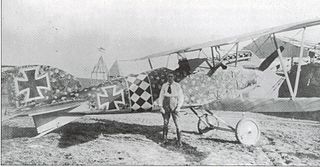Related Research Articles

Otto Kissenberth was a German flying ace of World War I credited with 20 aerial victories. He was a prewar mechanical engineer who joined the German air service in 1914. After being trained and after serving as a reconnaissance pilot, he became one of the first German fighter pilots, flying with Kampfeinsitzerkommando KEK Einsisheim. He scored six victories with this unit as it morphed into a fighter squadron, Jagdstaffel 16. His success brought him command of Jagdstaffel 23 on 4 August 1917. He would run his victory tally to 20, downing his final victim using a captured British Sopwith Camel on 20 May 1918. Nine days later, a crash while flying the Camel ended Kissenberth's combat career. His injuries were severe enough he was not returned to combat, instead being assigned to command Schleissheim's flying school. Although Otto Kissenberth survived the war, he died soon after in a mountaineering accident on 2 August 1919.

Max Ritter von Müller (1 January 1887 – 9 January 1918) PlM, IC, MOMJ was a German World War I fighter ace credited with 36 victories. He was the highest scoring Bavarian pilot of the war.

Oberleutnant Eduard Ritter von Dostler, Pour le Mérite, Royal House Order of Hohenzollern, Military Order of Max Joseph, Iron Cross, was a German World War I fighter ace credited with 26 victories. On three consecutive assignments during World War I, Dostler was entrusted with leadership of German jagdstaffeln.
Leutnant August Delling was a World War I flying ace credited with five aerial victories.
StandartenführerLudwig Gaim was a World War I flying ace credited with five aerial victories. He ended the war as a Vizefeldwebel.
SS-Gruppenführer Johannes Baur began his military career as a World War I flying ace credited with six aerial victories. He became Adolf Hitler's personal pilot in the 1930s. During World War II, he rose to the rank of Generalleutnant.
VizefeldwebelAlfred Hübner was a World War I flying ace credited with six aerial victories.
Vizefeldwebel Max Kahlow was a German World War I flying ace credited with six aerial victories.
VizefeldwebelErnst Wiehle was a World War I flying ace credited with six aerial victories.
VizefeldwebelGustav Schneidewind was a World War I flying ace credited with seven aerial victories.
Vizefeldwebel Kurt Ungewitter was a German test pilot for Rumpler Flugzeugwerke and Albatros Flugzeugwerke, aircraft manufacturers in 1913. During World War I, he became a flying ace credited with seven aerial victories. He died in a postwar flying accident on 14 March 1927.

VizefeldwebelFritz John Jacobsen was a German World War I flying ace credited with eight confirmed and two unconfirmed aerial victories.
Leutnant Walter Böning was a World War I flying ace from the Grand Duchy of Oldenburg credited with 17 aerial victories. He began his World War I military service as an infantryman. He distinguished himself by winning both the Gold Medal for Bravery and the Second Class Iron Cross. He then transferred to aviation duty, training originally as a reconnaissance pilot before advancing to become a fighter pilot. Between 6 April 1917 and 30 May 1918, he was credited with 17 aerial victories. On 31 May 1918, he survived a midair collision while being attacked by British fighters. Although he coaxed his damaged machine home, the serious leg wound he had suffered sidelined him through war's end.
Leutnant Ludwig Hanstein HOH, Bavaria's MMO was a World War I flying ace credited with 16 aerial victories.
LeutnantWilhelm Anton Seitz was a German World War I flying ace credited with 16 aerial victories. He scored those victories over a two-year span, beginning on 17 November 1916 and ending on 4 November 1918.
Vizefeldwebel Karl Bohnenkamp was a World War I flying ace credited with 15 aerial victories. He scored his first victory on 21 September 1917 and continued through 28 October 1918. His 15 victories made him the leading ace in his squadron. He was awarded the Military Merit Cross on the latter date.
LeutnantHermann Pfeiffer IC was a German World War I flying ace credited with eleven aerial victories.

Leutnant Rudolf Stark was a World War I flying ace credited with eleven confirmed and five unconfirmed aerial victories.
OffizierstellvertreterBernhard Ultsch was a World War I flying ace credited with twelve aerial victories.
Royal Bavarian Jagdstaffel 23 was a "hunting group" of the Luftstreitkräfte, the air arm of the Imperial German Army during World War I. As one of the original German fighter squadrons, the unit would score a minimum of 63 verified aerial victories. They scored twelve wins over enemy observation balloons as a squadron.
References
- Franks, Norman; Bailey, Frank W.; Guest, Russell. Above the Lines: The Aces and Fighter Units of the German Air Service, Naval Air Service and Flanders Marine Corps, 1914–1918. Grub Street, 1993. ISBN 0-948817-73-9, ISBN 978-0-948817-73-1.